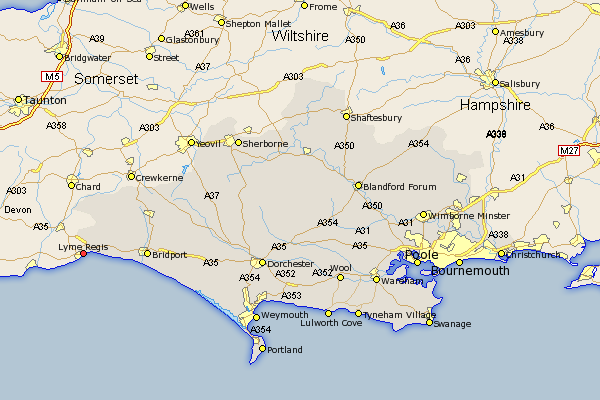The Mine: LCI(L) 310, 264th Flotilla
By John T. Corcoran, AB (Able Bodies Seaman), RCNVR
Lyme Bay is west (left) of Weymouth, S. England. Poole is to the east,
near Bournemouth. Photo Credit - Travel the UK
The following story appears in a rare set of Canadian texts, compiled by David and Catherine (Kit) Lewis and Len Birkenes in the mid-1990s, entitled St. Nazaire to Singapore: The Canadian Amphibious War 1941 - 1945, (Volumes 1 and 2). Links to the set can be found on this site under the click-on Heading "Books re Combined Operations" (right hand margin). The books open by telling us they were inspired by Combined Operations by Clayton Marks of London, Ontario.
The Mine by John T. Corcoran (Editted by David Lewis)
"It's strange how reading something like this (i.e., "Combined Operations", by C. Marks) opens other doors of past events that have been forgotten with the passing of time. One could recall a certain event, but it seems each one of us saw it in a different light, if he could recall it at all. This got me thinking about the mine incident outside Weymouth. I have been telling it as I saw it for forty-nine years. I may have added a bit now and then, but basically it was the truth. But to make sure, I checked my diary and one would think it a different event altogether. My diary must be wrong." Page 227
Mr. Corcoran (with, in GH's opinion, a big assist from David Lewis) then goes on to tell his story about the mine.
The story involves the Third Canadian Flotilla of landing crafts, after leaving their station in Southampton on March 24, 1944, and their participation in "difficult and advanced manoeuvres" - in the company of RN and US landing craft - in Lyme Bay near Portland.
Tank landing craft and infantry landing craft putting out to sea during
exercises near Portsmouth and Isle of Wight area. Photo taken on landing ship
infantry (LSI) EMPIRE MACE. Photo credit - WW2 Today
LCI(L) 310 was lead ship on a perfect day for exercises, upon water "still as a mill-pond." As they sailed east into intense reflections from the sun, Corcoran was amazed to behold such a large formation of Allied landing craft - and then - something else dead ahead. As bow lookout he began to jump up and down and wave his arms for attention.
"Then we saw it - 30 yards ahead - an ugly mine three quarters submerged."
No date is given in the recollection but an onboard diary reports:
April 8/44 - really dark - calm - hit something in water.
Too late to take evasive action (men aboard could only "wait and watch"), the craft hit the mine with the centre of the ship's flat-bottomed bow. LCI(L) 310 shuddered, "every rivet" seemed to shake, but the mine did not explode.
The mine rolled under the hull until it crashed and banged into the twin propellors. 310's stern jumped a bit, then the mine popped up 20 yards behind, with horns torn asunder and sporting fresh gashes from the props.
What to do? 310 was instructed to "Stay and protect" until an MTB (Motor Torpedo Boat) arrived to tow it back to a nearby Navy base.
The crew of LCI(L) 310 soon discovered they were unable to easily proceed with the exercise with severely damaged propellors. They were soon informed to "Proceed to HMS Turtle at Poole for inspection and repairs." Off they went in order to cover the distance of about 40 miles before dark.
Ship's staff soon learned (from an RN Intelligence Officer) that Germany had dropped "suspension mines at different depths" in Lyme Bay a few years earlier and the ones not cleared by minesweepers had since corroded and leaked but posed only a nuisance. We read, "He tells us that after we were scared out of ten years' growth!"
Rehearsal for D-Day, likely in S. England, on or near Lyme Bay
Photo as found in Combined Operations by C. Marks. Page 23
An onboard diary not only reveals the incident occurred in early April but repairs were not completed for 2 - 3 weeks.
The following is from the official accident report dated April 11, 1944 (perhaps submitted by Lt. David Lewis):
....The report of collision with a submerged object while carrying
out night exercises with the 264th LCI(L) Flotilla. The extent of the
damage is unknown at present and cannot be determined until ship
is put in a slipway.... A good lookout was kept, a reliable rating on
the forecastle head reports he did not see any object. LCI(L) 302
passed through the same position a minute previously and neither
saw nor hit any object....
By the time the crew of LCI(L) 310 returned to Southampton many signs of the vast buildup to D-Day Normandy were in evidence.
We read, "It wasn't the same Southampton we left eight weeks earlier. Then it was comfortable.... but now it is jammed."
The last diary entry (May 18/44) states:
"With repairs completed and trials and manoeuvres finished, we returned to Southampton ready to conquer the world."
A bold statement, is it not, three weeks before D-Day Normandy?
Please link to the complete story by J. Corcoran and D. Lewis. Pages 227 - 229
Please note the Canadian Maple Leaf on Bill Gunther's metal helmet.
Photo as found in St. Nazaire to Singapore, Vol. 2, Page 226
Photo as found in St. Nazaire to Singapore, Vol. 2, Page 226
Please link to Story: A Mediterranean Lighter Man
Unattributed Photos GH


No comments:
Post a Comment